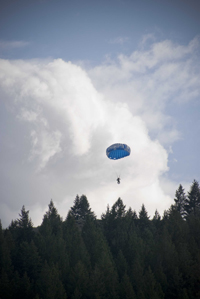The eight U.S. Forest Service smokejumpers parachuting down to the small lightning-caused blaze Tuesday afternoon were just the first of several indicators suggesting local fire officials were taking the plume of smoke seriously.
Silhouetted against tall, bright-white thunderclouds set against the blue summertime sky to the west, the jumpers leapt two at a time from a bright orange, yellow and white Forest Service DC-3 turboprop airplane. They landed just downhill from the billowing smoke and torching trees on a barren ridgetop just east of Oregon Gulch.
Dubbed the North Fork Fire, the blaze was first reported to local fire officials around 4 p.m. Tuesday, just after a fast-moving thunderstorm passed over the region trailing numerous bolts of lightning and moderate amounts of rainfall in its wake.
Joined by eight U.S. Bureau of Land Management helitack crew members from Twin Falls and six engine crew firefighters from the Sawtooth National Forest's local Ketchum Ranger District, the fire crews were able to contain the fire by 11 p.m. Tuesday night. Full containment is when fire crews are able to circle a blaze with handline to stop a fire's spread.
The ground-based crews were joined by two Single Engine Air Tankers, or SEATS, and a BLM helicopter that made repeated bucket drops of water on the blaze throughout the evening to knock the flames down. At several points, the light-duty Bell helicopter could be seen hovering over tall flames leaping up from live green trees that were "torching out."
By 4 p.m. Wednesday, the crews had the blaze under control, meaning no visible flames could be seen inside the fire lines.
"We hit it hard with our resources to get it contained," said the Sawtooth National Forest's north zone fire management officer Bill Murphy. Murphy acted as incident commander on the blaze until the smokejumpers took over.
The jumpers stayed on to monitor and strengthen the fire lines all through the night.
Acknowledging that local Wood River Valley residents are sensitive to the threat posed by wildfire in light of last summer's Castle Rock Fire, Murphy said officials didn't want to let the North Fork Fire creep over the ridge and allow it to take off. Ironically, the fire crews were only working a mile or so from blackened trees and new growth that serve as evidence of the 48,520-acre fire.
"The crews did a great job. We hit it hard and fast," Murphy said.
The fire crews were aided in their fight by fuel conditions that are much better off than they were at the same time last summer, Murphy said. As early as late June last summer, conditions were more like they typically are in August, he said.
Had the conditions been as dry, the North Fork Fire would have been difficult to stop, Murphy said.
"This fire would have gotten bigger, quicker," he said.
Murphy said the Forest Service plane actually had 12 smokejumpers on board, but he asked them to keep four from jumping in case other fires ignited elsewhere in the hours after the thunderstorm passed over. It turned out to be a good call.
Flying around the region after the eight jumpers were dropped off at the local blaze, they discovered another fire near Potaman Peak on the northeast corner of the Sawtooth National Recreation Area in the northern White Cloud Mountains. Murphy said the remaining jumpers were able to contain that lightning-caused Potaman Fire by Tuesday night.
"I had a feeling we had more fires," he said.
Fire officials are still keeping a close watch in case more fires pop up, he said. Lightning-caused blazes can smolder for days before igniting, he said.
"Those can be reported to us by hikers or aircraft," he said.
Murphy reminded people that even though local hillsides may look green, the local fire danger has become significant.
"It's deceiving," he said. "Our conditions are drying."


 A U.S. Forest Service smokejumper from McCall nears the ground near the North Fork Fire northwest of Ketchum Tuesday evening. In all, eight smokejumpers joined eight helitack crew members from Twin Falls and six engine crew firefighters from the Sawtooth National Forest to bring the blaze under control by Wednesday afternoon. Photo by Jason Kauffman
A U.S. Forest Service smokejumper from McCall nears the ground near the North Fork Fire northwest of Ketchum Tuesday evening. In all, eight smokejumpers joined eight helitack crew members from Twin Falls and six engine crew firefighters from the Sawtooth National Forest to bring the blaze under control by Wednesday afternoon. Photo by Jason Kauffman



































